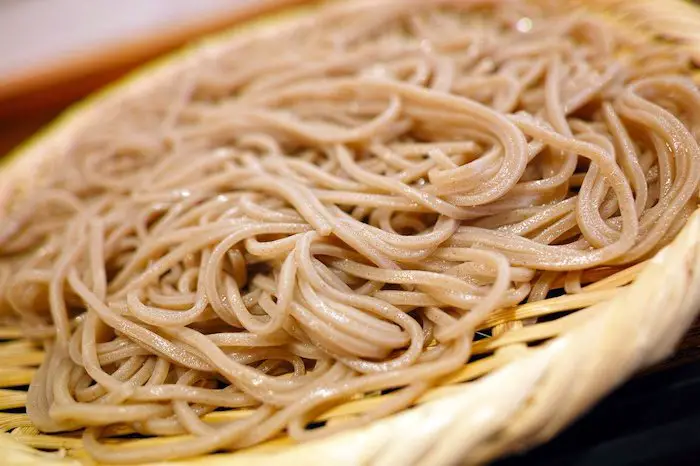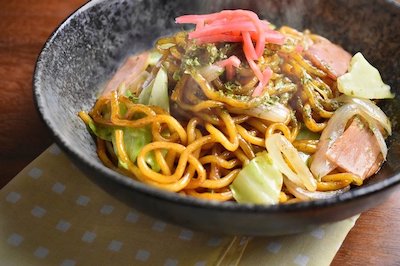We are reader supported. When you purchase through links on our site, we may earn an affiliate commission. Also, as an Amazon affiliate, we earn from qualifying purchases.

If you are a fan of Japanese food, you likely want to try the various noodle options in every possible concoction. One of my favorites is Japanese yakisoba, a Chinese-styled buckwheat noodles mixed with pork belly, diced meat, and veggies. Yakisoba is often tossed with a thick and sweet sauce, such as standard yakisoba sauce or even tonkatsu.
People often ask, “Can you use yakisoba noodles for ramen?”
The simple answer is yes. It’s perfectly fine to use yakisoba noodles for making ramen. These noodles are packaged after steaming; hence, they are much simpler and easier to cook. You typically only need them to quickly reheat them to make them ready to eat, although many individuals choose to still recook them with their preferred toppings. Additionally, the texture of yakisoba noodles is very similar to ramen noodles as well.
Similar to ramen, yakisoba is also a relatively recent creation that came from China, but it first appeared in Japan during the early 20th century. Although it’s mostly served as a fried noodle, other creations using this ingredient also include the yakisoba pan in which the noodles are laid lengthwise and garnished like a hot dog. You can enhance the taste and flavor of the dish with a variety of condiments and garnishes including beni shoga (pickled ginger), tsukemono (pickles), katsuobushi (dried bonito flakes), bean sprouts, sliced scallions, aonori (dried seaweed), and a little sesame oil.
There are a few things that you need to keep in mind when using the yakisoba noodles for ramen, though, one being that some brands don’t include egg or kansui in the ingredient list. Due to this, the yakisoba noodles tend to absorb more moisture than ramen noodles do, so they become notably softer in just a few minutes compared to standard ramen cooking.
Contents
The Right Way to Make Yakisoba Noodles
When you use yakisoba noodles, make sure you have the right set of cookware and ingredients to help you create the right flavors. Here are a few tips that can help you achieve that authentic taste.
Using the right type of noodles
You can buy the pre-steamed yakisoba noodles or mushi chukamen noodles from any Asian grocery store. These noodles appear and feel like ramen, but they give you a slightly more delicate texture after being cooked.
Using the right type of cookware
Simply cooking the dish correctly is not enough; you must also use the right kind of cookware to get your desired results. For instance, a wok (see Amazon) tends to conduct heat differently than a standard skillet or frying pan. With the right kind of cookware, you can ensure that the noodles don’t get too soft or gummy and that the overall textures and flavors are accurate.
Making your sauce
You can find pre-made varieties of yakisoba sauce in almost all Asian grocery stores, but it’s actually quite easy to make at home as well. You simply need to mix three tablespoons of Worcestershire sauce with three teaspoons of oyster sauce, two teaspoons of soy sauce, two teaspoons of ketchup, and a little sugar to taste. Whisk all of these ingredients together, and adjust the ratios to suit your preferences.
Other Noodles Substitutes for Making Ramen
While yakisoba noodles are a great option for making delicious ramen when you don’t have ramen noodles themselves, if you are thinking about the moisture content and softness issues, there are also some other noodle options you can try.
Rice Noodles
Just as the name suggests, rice noodles are made from rice flour—no points for guessing that right! These noodles are known for their semi-transparent appearance and a chewy texture that sets them apart from the other varieties available for purchase.
Rice noodles can be added to dishes like Pad Thai or Pho. Besides that, though, these noodles can also be used to make great-tasting ramen. They add a lot to the rich broth of the dish. Aside from rice noodles, some people may also use rice paste instead.
Soba Noodles

The next obvious choice for a substitute is soba noodles, commonly known as buckwheat noodles as they are made from buckwheat flour. They have a thin form, and you can frequently find them in many Japanese dishes. Although soba noodles are typically found more often in cold dishes, they also make a great addition to hot soups. Therefore, they are suitable for use in ramen dishes, too.
The texture of soba noodles is similar to ramen too, which is a huge plus.
Kelp Noodles
If you are looking for an option that has rich nutritional content, we would suggest using kelp noodles (see Amazon). These noodles not only taste amazing, but they are loaded with iodine, vitamin K, calcium, and iron, and they also have zero fats. Kelp noodles also have a chewy texture that works wonderfully for ramen.
Glass Noodles
Just as the name suggests, glass noodles are thin and transparent noodles that are often referred to as “cellophane noodles.” Their appearance is similar to clear pieces of thread, and they make a great addition to ramen as well as for making stir-fry dishes. Glass noodles also have a light flavor and a springy texture, which works very well for ramen purposes.
Tips to Make Your Ramen Taste Better
Now that you know whether you can use yakisoba noodles for ramen or not, let’s look at a few tips that can make your ramen noodles taste better, too. There are many ways in which you can enhance the flavor and taste of this dish.
- To get that authentic umami flavor in your ramen broth, we suggest that you mix miso with the boiling water, and then add that to the soup. You can even add pork or chicken bones with the miso as well to get a richer taste.
- You can whisk in an egg and poach it in ramen to make it fuller, tastier, and also more nutritious. This is a great way to add more flavor and protein content to your broth. Some people may use egg to acquire a creamier texture in their dish as well.
- If you are looking for a Thai-inspired ramen hack, we suggest that you cook the noodles according to the instructions, but skip the traditional flavorings. Instead, add a mixture of sesame oil, peanut butter, soy sauce, honey, rice vinegar, garlic, and ginger. Also, you can add scallions and sesame seeds to enhance the flavor even further.
- Pump up the flavors even more by using seasonings like furikake, a Japanese seasoning that contains sesame seeds, seaweed, and fish flakes. You can also try togarashi, which is a spicy seasoning made of dried pepper flakes, seaweed, and sesame seeds.
- Add some frozen or fresh vegetables to your ramen soup to enhance the taste and flavor. Let the vegetables wilt in the pot with the broth. This also helps in adding more nutrition to the dish, too. Some examples of vegetables that work well for this purpose are spinach, bok choy, corn, peas, carrots, and cabbage.
- Top off your ramen with a sheet of seaweed or nori to add a salty crunch to your dish. This will improve the taste, and it will also add more umami flavor to the food.
These are just a few tips to help your ramen taste even more amazing than usual, but there are plenty of other options as well. Try experimenting when you have time to discover the ingredients and seasonings that work best to meet your specific tastes.
Related questions
Can you use any type of noodles for ramen?
Mostly, yes. You can add numerous different varieties of noodles—such as rice noodles, soba noodles, kelp noodles, etc.—but it’s best to ensure that the cooked state of your chosen noodle is an appropriate size, texture, and flavor to make the dish as appealing as possible.
Are yakisoba noodles the same as udon?
Not exactly. Yakisoba noodles are more round in shape, and they are also much smaller and thinner than udon noodles. Udon is typically far more thick and used in broth-based dishes compared to yakisoba.
See Also:
Is Japanese Ramen Healthy (Explained)
What Does Takoyaki Taste Like?
Can You Make Ramen In The Microwave? (Guide)
Can You Eat Ramen Raw? Read This First!




